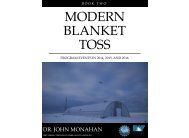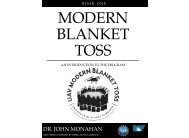Modern Blanket Toss: Findings and Observations
This book is the last in a series of three covering the National Science Foundation awarded Modern Blanket Toss project. In this book are the evaluation findings for each of the three years as well as observations from Modern Blanket Toss staff.
This book is the last in a series of three covering the National Science Foundation awarded Modern Blanket Toss project. In this book are the evaluation findings for each of the three years as well as observations from Modern Blanket Toss staff.
You also want an ePaper? Increase the reach of your titles
YUMPU automatically turns print PDFs into web optimized ePapers that Google loves.
2014 FINDINGS<br />
2014<br />
Both surveys asked students about their previous experience with mapping <strong>and</strong><br />
UAVs <strong>and</strong> if they were excited to learn about such things. Students were given<br />
the option to strongly agree or agree <strong>and</strong> more students strongly agreed in the<br />
post test. This is shown by the average score for each question. The more<br />
respondents chose “strongly agree,” the closer the average gets to 4. Results are<br />
shown in Table 3.<br />
Table 3 Experience <strong>and</strong> Excitement to Learn<br />
Skill<br />
Pre-<br />
Average<br />
Post-<br />
Average<br />
Change<br />
I am excited to learn about mapping software. 2.88 3.13 0.25<br />
I am excited to learn about UAV’s. 3.63 3.69 0.06<br />
I have used mapping software before. 1.94 2.44 0.5<br />
I have used UAV’s before. 2.75 3.63 0.88<br />
Table 4 Content Knowledge Items<br />
Skill<br />
Pre-<br />
Average<br />
Post-<br />
Average<br />
Change<br />
How to acquire data from databases 2.56 7.38 4.81<br />
How to use a 3-D printer 1.25 5.69 4.44<br />
How to acquire different types of data using<br />
UAV’s<br />
3 7.19 4.19<br />
Applications of UAV technology 4.31 8.4 4.09<br />
How to use data collected to develop a map/<br />
image that represents reality<br />
2.75 6.56 3.81<br />
How to ask questions using GIS software 2 5.75 3.75<br />
How to fly a UAV 5.5 9.19 3.69<br />
How to use GIS mapping software 1.81 5.06 3.25<br />
The amount of money I can earn from science,<br />
technology, engineering or math career<br />
The safety rules <strong>and</strong> regulations that apply to<br />
flying a UAV<br />
5.06 7.94 2.88<br />
6.25 9.13 2.88<br />
Principles of flight (e.g., lift, drag, gravity) 5.67 8.5 2.83<br />
The range of science, technology, engineering<br />
<strong>and</strong> math careers that are available to me<br />
5.06 7.87 2.8<br />
How to build a UAV 2.88 5.56 2.69<br />
The level of man <strong>and</strong> science I will need for<br />
various science, technology, engineering, <strong>and</strong><br />
math careers<br />
5.5 7.81 2.31<br />
It is valuable to know the average responses for individual items within each<br />
construct. Students were asked to rate their knowledge on each topic on a scale<br />
of 1 (low knowledge) to 10 (high knowledge). Predictably, students reported<br />
learning more about how to safely <strong>and</strong> legally fly a UAV, than how to use a 3-D<br />
printer or ask questions using GIS software. See Table 4.<br />
10




